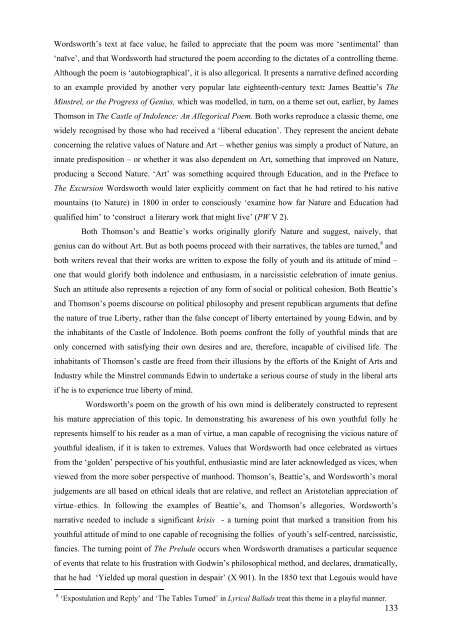Contents - ResearchSpace@Auckland - The University of Auckland
Contents - ResearchSpace@Auckland - The University of Auckland
Contents - ResearchSpace@Auckland - The University of Auckland
You also want an ePaper? Increase the reach of your titles
YUMPU automatically turns print PDFs into web optimized ePapers that Google loves.
Wordsworth’s text at face value, he failed to appreciate that the poem was more ‘sentimental’ than‘naïve’, and that Wordsworth had structured the poem according to the dictates <strong>of</strong> a controlling theme.Although the poem is ‘autobiographical’, it is also allegorical. It presents a narrative defined accordingto an example provided by another very popular late eighteenth-century text: James Beattie’s <strong>The</strong>Minstrel, or the Progress <strong>of</strong> Genius, which was modelled, in turn, on a theme set out, earlier, by JamesThomson in <strong>The</strong> Castle <strong>of</strong> Indolence: An Allegorical Poem. Both works reproduce a classic theme, onewidely recognised by those who had received a ‘liberal education’. <strong>The</strong>y represent the ancient debateconcerning the relative values <strong>of</strong> Nature and Art – whether genius was simply a product <strong>of</strong> Nature, aninnate predisposition – or whether it was also dependent on Art, something that improved on Nature,producing a Second Nature. ‘Art’ was something acquired through Education, and in the Preface to<strong>The</strong> Excursion Wordsworth would later explicitly comment on fact that he had retired to his nativemountains (to Nature) in 1800 in order to consciously ‘examine how far Nature and Education hadqualified him’ to ‘construct a literary work that might live’ (PW V 2).Both Thomson’s and Beattie’s works originally glorify Nature and suggest, naively, thatgenius can do without Art. But as both poems proceed with their narratives, the tables are turned, 8 andboth writers reveal that their works are written to expose the folly <strong>of</strong> youth and its attitude <strong>of</strong> mind –one that would glorify both indolence and enthusiasm, in a narcissistic celebration <strong>of</strong> innate genius.Such an attitude also represents a rejection <strong>of</strong> any form <strong>of</strong> social or political cohesion. Both Beattie’sand Thomson’s poems discourse on political philosophy and present republican arguments that definethe nature <strong>of</strong> true Liberty, rather than the false concept <strong>of</strong> liberty entertained by young Edwin, and bythe inhabitants <strong>of</strong> the Castle <strong>of</strong> Indolence. Both poems confront the folly <strong>of</strong> youthful minds that areonly concerned with satisfying their own desires and are, therefore, incapable <strong>of</strong> civilised life. <strong>The</strong>inhabitants <strong>of</strong> Thomson’s castle are freed from their illusions by the efforts <strong>of</strong> the Knight <strong>of</strong> Arts andIndustry while the Minstrel commands Edwin to undertake a serious course <strong>of</strong> study in the liberal artsif he is to experience true liberty <strong>of</strong> mind.Wordsworth’s poem on the growth <strong>of</strong> his own mind is deliberately constructed to representhis mature appreciation <strong>of</strong> this topic. In demonstrating his awareness <strong>of</strong> his own youthful folly herepresents himself to his reader as a man <strong>of</strong> virtue, a man capable <strong>of</strong> recognising the vicious nature <strong>of</strong>youthful idealism, if it is taken to extremes. Values that Wordsworth had once celebrated as virtuesfrom the ‘golden’ perspective <strong>of</strong> his youthful, enthusiastic mind are later acknowledged as vices, whenviewed from the more sober perspective <strong>of</strong> manhood. Thomson’s, Beattie’s, and Wordsworth’s moraljudgements are all based on ethical ideals that are relative, and reflect an Aristotelian appreciation <strong>of</strong>virtue–ethics. In following the examples <strong>of</strong> Beattie’s, and Thomson’s allegories, Wordsworth’snarrative needed to include a significant krisis - a turning point that marked a transition from hisyouthful attitude <strong>of</strong> mind to one capable <strong>of</strong> recognising the follies <strong>of</strong> youth’s self-centred, narcissistic,fancies. <strong>The</strong> turning point <strong>of</strong> <strong>The</strong> Prelude occurs when Wordsworth dramatises a particular sequence<strong>of</strong> events that relate to his frustration with Godwin’s philosophical method, and declares, dramatically,that he had ‘Yielded up moral question in despair’ (X 901). In the 1850 text that Legouis would have8 ‘Expostulation and Reply’ and ‘<strong>The</strong> Tables Turned’ in Lyrical Ballads treat this theme in a playful manner.133














